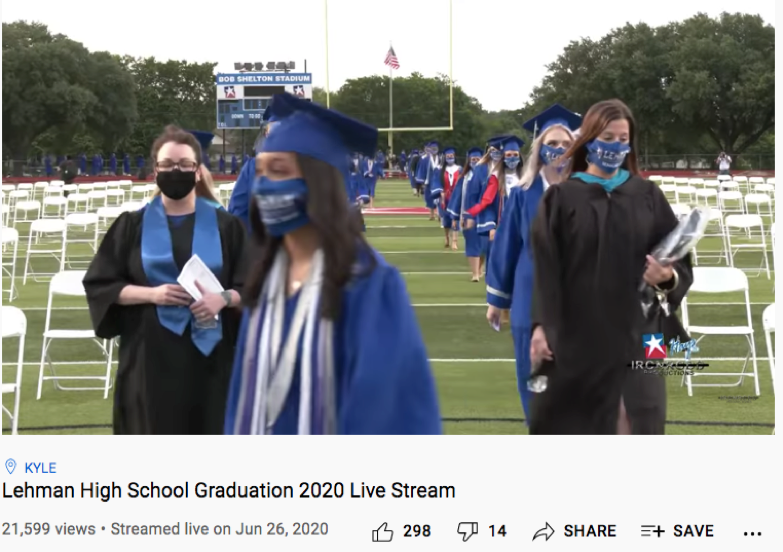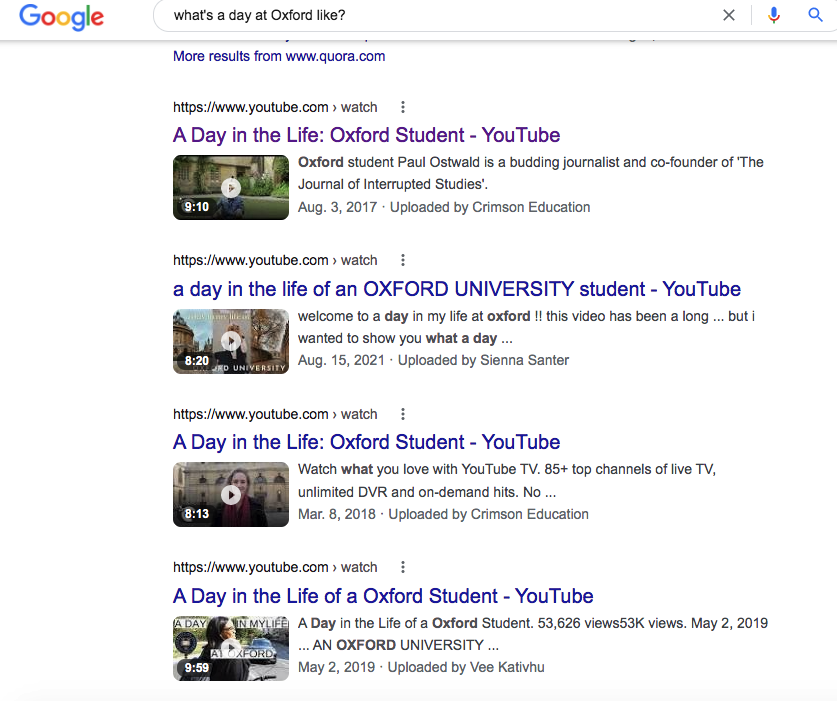Video is the ultimate format for storytelling, allowing you to transport your prospects to the football field, science lab, library, and food court , giving them a real sense of what it’s like being there. You can live stream events, promote new courses, and tell student stories – all in a way that allows you to effectively connect emotionally with your prospects.
Ultimately, it’s this connection that will help you to nurture your prospects throughout the enrollment journey as they conduct their own online research of school options. Whether you’re just starting out with video or want to improve your current content, we’ll walk you through some key aspects for getting your video strategy into the best shape it can be!

Define the Goals of Your School’s Video Content Strategy
So you know you want to use video as part of your education content marketing strategy. The next step is asking yourself why you want to use it. The answer to this question will help direct the focus of your strategy and the video content that you produce. Some typical examples of marketing goals for your school’s video content may include:
- Increasing conversions
- Gaining leads
- Building awareness around a new program
- Increasing engagement on social media
- Using story to build brand engagement
Once the goal of your video marketing campaign is defined, the messaging you create in your content should reflect that central goal to keep your strategy consistently focused. If your primary goal is to build awareness through an upcoming open day at your school, for example, you might create videos showcasing that event. If your goal is to announce a new course or program, the video content you produce should focus on that. Your goals will evolve over time, as new events and course offerings become available at your school. As a result, your videos should contain content reflecting these changes.
Choose the Type of Video Your School Wants to Create
There are several different types of videos your school can create with various goals in mind, from spotlighting school updates to profiling students or staff members, to promoting special events. Let’s take a quick look at a few of the most popular types of videos used in content marketing for schools.
Campus Tour Videos
The next best thing to taking your prospects on an in-person tour of your school is taking them around your campus virtually. No matter how much budget you funnel towards your school’s campus tour videos or what theme you decide to pursue, in all cases you should be looking to create informative content that’s also entertaining to increase the likelihood of shares and views.
Example: This video from Stanford University hits the mark, featuring a charismatic student star touring viewers all around the most beautiful landmarks of the campus. The video is fun but has also been carefully scripted to include elite aspects of the school.

In campus tour videos, give your prospects an intimate peek of your school’s more engaging classrooms or take them to a favourite student campus hangout to let them experience what it’s like to be there.
Example: The same video production shows prospects what students do when they’re not studying, showcasing a unique tradition at the school called “fountain hopping” – where students hop from fountain to fountain to keep cool on hot days.

The more up close and personal you can get with your video content like this, the more likely you’ll be to make that emotional connection with your viewers, motivating them to learn more about your school and its programs.
Live Stream
Whether it’s an upcoming sporting event, a graduation ceremony, or an open day, your school might opt to live stream some key events. Live Streaming video is a great tool to experiment with, known to receive up to three times more engagement than on-demand video.
Example: This live stream from Lehman Highschool received an impressive 21,000+ views and a lot of engagement.

Live Streaming events like these can help prospective students discover something special about your school they might not have noticed from a simple visit to your website. This could be key according to this study from educations.com, which reveals that undergrad students pondering future schools were 36% more likely to be influenced by unique factors of educational institutions. Even more impressive from the same study is this stat: undergrad students were 123% more likely to reference a virtual open day as an influence on their school of choice. If you’re thinking of featuring live coverage of an upcoming event, both Facebook and Instagram have great live streaming features that your school can take advantage of.
Create Short Videos Through Your School’s Social Media Platforms
If you’re not interested in live streaming events, you can still give viewers a timely snapshot of important things going on at your school through Snapchat, or Facebook and Instagram Stories. These platforms share the format of posting short videos and images that disappear after 24 hours, allowing your school to promote events as they come up that you may not necessarily want to be included as permanent posts on your social media accounts.
The short, 15-second videos let you add clickable links, stickers, hashtags and messaging options to increase engagement. By publishing a regular stream of content showcasing fun and fleeting imagery of campus life and live events, your followers will feel more connected to your school day to day, giving you a better shot at grooming interested prospects further towards enrollment.
Student Testimonials
One of the most compelling ways to spotlight your school is to showcase your current students or alumni discussing their own experiences at your institution. These videos can be highly effective for influencing prospective students pondering their higher education options
Example: This video production from Oxford University targets international prospects. The video uses a voiceover from a narrator and features current students enjoying daily life at the famed educational institution. As you can see, the video has received more than 65,000 views to date.

While the video above contains many sophisticated design elements, not all videos need to be this complex in order to reach the desired goal. In fact, many schools are leveraging tools such as Instagram Reels and TikTok videos as a way of quickly creating simple videos. Not only do these short-form videos get plenty of views and engagement, but they’re also very easy for your marketing team to create and do not require formal video training.
Example: This video from the University of Florida shows students enjoying downtime at various corners of campus. It received over 82,000 views and great levels of engagement.

Student ambassadors or social media influencers at your school are a good bet to work with, as they’ll have great ideas of the type of video content that’s trending and capable of going viral.
Don’t Overlook Short Form Video in Your School’s Strategy
Your school shouldn’t underestimate the power of short-form video formats found on apps including TikTok and Instagram Reels for their potential reach and impact. TikTok currently maintains its position as the fastest growing social media platform, recently overtaking Facebook as the world’s most downloaded app. In fact, TikTok’s wild popularity inspired Instagram’s own similar feature called Reels. Just like TikTok, Instagram Reels let users create highly entertaining, shareable videos through a variety of features, effects, and musical selections.
Not sure how to get started on these platforms, and get the most mileage you can from them in your video strategy? Both TikTok and Instagram Reels call for 15-second videos on average, which may sound like a short time to get your school’s messaging across – but can be used effectively by following these quick tips:
- Create content that’s entertaining, funny, and interesting to make your content more discoverable
- Feature students in your videos in ways that show off your campus and courses
- Find social media savvy student ambassadors to help create your school videos
- Re-purpose your TikTok creations on Reels and vice versa to boost views and extend your reach
- Find out what’s trending locally on either platform and try your own (e.g. hashtag dance challenges, or any type of trending challenge)
Example: The University of Florida Student Body President accepted a challenge to shave his head and dye the sides of his remaining hair in the school colours of orange and blue – all in the spirit of IG Reels challenges. As you can see, the video gained an impressive 229,000 views and plenty of engagement.

Following these simple few tips can help make your content more impactful, which means more shares to expand the overall reach you achieve with your video content.
Select Where You’d Like to Distribute Your School’s Video Content
In your school’s approach to content marketing for higher education, you’ll need to decide on the best place to display your video creations. Beyond sharing your video through all of your school’s social media channels, you can also display it right on your website. Here, it can serve as an attractive visual feature that can encourage new website visitors to check out programs or events you’d like to promote. It’s also the perfect opportunity to give prospects a visual introduction to your school.
Example: The Vancouver Film School gives a great introductory overview of the school through a “Showreel” to showcase some of the projects students and alumni were involved with, in 2021. It also lets the school summarize awards received over the past year.

You can also change the video on your homepage to update any important messages you wish to convey in the moment.
Example: This video on the McGill University homepage showcases the school’s 200-year history, starting with a tribute to the Indigenous people that the school’s location is connected to. The video was released at a sensitive time in Canadian history surrounding relations with Indigenous peoples.

According to Forbes, 87% of marketers shared in a report that “video gives them a good return on their investment.” Forbes also reports over 90% of businesses gain new customers from branded video content. With these stats in mind, it seems a good bet that those in the educational field will also gain new leads and enrollments by adding video to their websites and other channels.
Optimize Your Videos for Conversion
To motivate your viewers to take action after watching your video content, you’ll need to optimize your videos for conversion just as you would with your school’s web pages, blog posts, paid promotional materials, or other content.
That’s why it’s important to incorporate a few key elements, starting with a call to action (CTA). A call to action is the short bit of text added to your messaging that serves to prompt your prospects into taking an action (e.g.: “To learn more, visit this page”, “Download our helpful guide today,” etc.). Your CTAs can be added in the description associated with your video, as seen below from the Stanford Campus Tour video referenced earlier:

In this case, the CTA comes in the form of the button above asking the viewer to “Subscribe” to the channel. As you can see, the channel has a healthy audience, at 1.52 million subscribers.
You can also add CTAs to your video’s end screen – the final 15-20 seconds of your video, where YouTube allows users to suggest other videos, to subscribe to their channel, and to promote their website and overall brand. Remember to reiterate your CTAs by having them mentioned by the student or other talent featured in your video at the same time they appear, as seen here:

Additionally, you’ll need to consider optimizing all the videos you upload to YouTube for SEO. Keep in mind that YouTube represents the second largest search engine behind its owner, Google. By including an SEO optimized title to your video along with some optimized descriptor text, your video has the opportunity to rank in Google and come up alongside your prospects’ searches there – not just in YouTube.
Example: Note the selections that come up to this user’s search “what’s a day at Oxford like?” – with all of these search results including some combination of similar keywords in their video titles.

Be Sure to Monitor the Performance of Your School’s Video
You’ll need to measure the success of your videos to find out whether your video strategy has been worth the investment. To that end, analytics becomes an essential tool for your school’s marketing team. You can keep an eye on a few stand-out metrics to understand the impact and reach of your videos, and to identify areas in need of improvement
Starting with YouTube, you can track the performance of your video creations by monitoring YouTube Analytics. You can also use Google Analytics to monitor your YouTube videos since Google owns the platform. Both these measurement tools will give your school insight into some key metrics, including:
- Click-through rate (CTR)
- View time
- Viewer demographics
- Most popular videos
Using these tools, you’ll also be able to measure your overall brand awareness based on the total number of views, as well as the number of shares and mentions associated with the video in question.
The other social channels you’ll be using, such as Facebook, Instagram, Twitter, and LinkedIn, also have their own metrics tools that you can pay close attention to. The specific data available to measure on these platforms vary from one to the next, but some examples of the metrics covered include:
- Reach
- Engagement
- Average watch time
- Audience retention
- Audience demographics
- Top Videos
- Followers
Each of the social platforms mentioned above contains an insights or analytics section that can be easily accessed, either found on your account homepage or simply by clicking the video in question to produce a tab revealing the video’s metrics.
To track analytics on TikTok, you’ll need to have a Pro account, which allows creators to keep track of the performance of their videos. Here, you’ll be able to track important analytics such as how well your videos are performing compared to your competitors, or how many new followers you gained upon posting your latest video, and which video of your content is trending or the most engaging to your audiences.
Since you’ll likely be using a few social platforms to create or share your videos, it would be difficult to keep tabs on every single metric available to you. Instead, you can focus your monitoring efforts by tying things back again to your original video strategy goals. If you’re trying to raise the number of followers on one or more of the platforms, those are the metrics to watch for following your video’s launch. If you’re looking to increase overall engagement with your audiences, be sure to check total likes, comments, shares and other forms of engagement connected to your video content. Finally, if you have a combination of goals, be sure to monitor all the associated metrics on the platforms you’re leveraging.
Through a thorough analysis of your video performance, you’ll have the opportunity to improve the effectiveness of your school’s video strategy over time by identifying which content is the most impactful with your viewers. Monitoring metrics also helps you to understand which type of video tends to drive the most traffic to your website, so your school can keep generating the video content that works.







